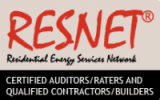The four seasons in Colorado bring beauty and thrill to those who live in this part of the country. However, temperature shifts and winds of the changing seasons can reveal homes experiencing air leaks. This happens when hot and cold air comes in and out of the house without an invitation.
What is the Big Deal About Air Leaks?
So, what is the impact of these air leaks? After all, is it not good for all things to breathe? Unfortunately, too much of this “breathing” leads to loss of heat or air conditioning, decreased energy efficiency, and increased heating and cooling costs.
The Rising Cost of Air Leaks
Air leaks in homes tend to be the most costly in the summer and winter months. The extreme temperatures of these seasons push homeowners to increase the use of heating or air conditioning. The more leaks you have in a home, the higher your HVAC system runs and the harder it must work to regulate a home’s temperature against the outside elements. Few homes are exempt from this malady. In fact, Energy Star reports that adding up the leaks, holes and gaps in a typical home amounts to leaving a window open every day of the year. That’s a lot of lost air, not to mention dollars.
Detecting Air Leaks
Homeowners probably know the front lines of air leak detection. Snuggling in to read a book on a rainy fall day or playing a family game of Monopoly may reveal the presence of air leaks in a home. The draft that requires a homeowner to grab a blanket or pull on a sweatshirt offers a sure sign that an issue exists. However, there is a more scientific way to detect the full range of air leaks.
When and Where to Look
Dropping temperatures of mid to late fall prove an ideal time to check for air leaks. A windy day offers a perfect opportunity to hunt down culprits as airflow becomes more easily detected. Air leaks often whistle in through windows, doorways, gaps along baseboards, electrical outlets and switches, plumbing fixtures, lighting features, dryer vents, and fireplace dampers. Be sure to check all of these areas in the search, noting everything from ceiling to floor. Drafts and signs of insects or critters entering an area offer clues for homeowners regarding the location of air leaks. Dirty carpet or ceiling areas suggest leaks around interior joints and joists.
The Fix
Once air leaks are located, remedying the cause improves temperature control within the home. And, the fixes range from simple to more complex. Knowing your skills as a handyman (or woman) proves important in tackling a bit of DIY or hiring a professional.
Simple Fixes
A few simple fixes to stop air leaks include installing foam gaskets behind outlet and switch plates on exterior walls, covering kitchen exhaust fans when not in use, and replacing seals around doors and attic entrances.
More Complex Solutions
While these simpler, less costly fixes prove to increase energy efficiency and save money, the real issue may lie uncorrected. Improper insulation leads to air loss throughout the home. According to experts in the field, nine out of ten homes lack proper insulation. This problem may particularly affect older homes built when insulation codes were not required.
Why Check it Out?
Reasons to check the quality and status of a home’s insulation might include the presence of drafts, specific rooms being hotter or colder than other, and problems with infestations. Other reasons include roof leaks, the occurrence of mold or mildew, and after reconstruction work, such as HVAC or electrical. Each of these situations potentially compromises the integrity of insulation and impacts its ability to maintain home temperatures comfortable for homeowners.
Replace Poor Insulation
Replacing poor insulation is beneficial to achieving energy efficiency and cost savings. In fact, proper insulation combined with air sealing saves homeowners 20 to 40 percent on their energy bills. Insulation also offers improvement in a home’s overall comfort by reducing noise and decreasing pollen, pests and dust. Plus, homeowner enjoys greater humidity control and reduced risk of ice dams. Addressing the air leaks in a home makes for more comfortable living beyond just controlling your home’s temperature.
How Do Energy Audits Help?
While DIYers often choose to tackle home issues, such as energy audits, the Department of Energy recommends homeowners use a professional technician or energy auditor. A self-audit helps professionals better analyze areas for increased savings. However, a professional digs deeper and offer other services. A typical audit measures the energy a home consumes to identify the means to achieve efficiency. In this assessment, an auditor should check for leaks, examine insulation, perform blower door tests, inspect the furnace and any ductwork, and review past utility bills.
Hiring a professional ensures greater thoroughness and detail than DIY assessments provide. Energy auditors locate leaks beyond the obvious and provide measurements of exactly how much loss home experiences. Whether a homeowner chooses a professional or self-audit to begin, this assessment begins the process of increasing energy efficiency and decreasing the costs of heating and cooling a home.
Thank you for reading our blog! How can we help you? Contact us today.



